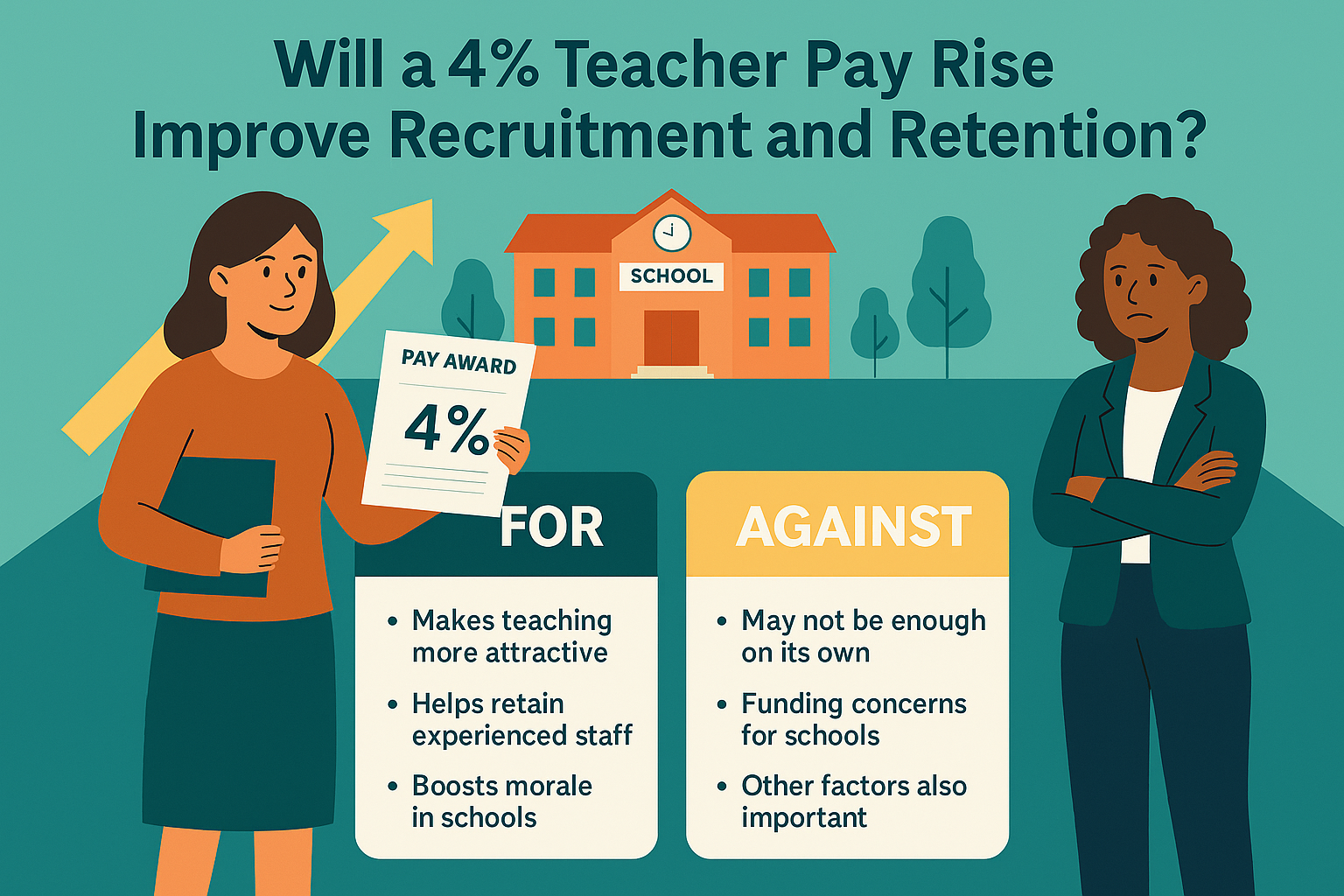Teacher Pay Rise 2025
4% Teacher Pay Rise: What It Means for Recruitment & Retention

Tuesday 24th June 2025 | Estimated reading time: 7 mins
Great news for teachers – the UK government has confirmed a 4% pay rise for school teachers, effective from September 2025. This uplift, recommended by the independent School Teachers’ Review Body (STRB) and accepted in full by the Department for Education, is designed to address ongoing challenges in teacher recruitment and retention [Source]. In this post, we break down what this pay award means for you, whether you’re a current teacher or considering joining the profession.
Why a 4% Pay Rise – and Why Now?
Teacher pay has been a hot topic in recent years. After a decade of below-inflation raises, teacher salaries had fallen behind those in other graduate professions. For example, in 2022 teachers saw a 5% raise while inflation hit ~11%, leaving many feeling the pinch. The new 4% pay award represents a shift – it slightly exceeds current inflation (around 3.5%) to finally give a modest real-terms increase. Importantly, the STRB explicitly recommended this level to help make teaching more competitive and to avoid worsening the teacher shortage [STRB report summary]. Initially, a lower rise (2.8%) had been floated, but strong evidence of a recruitment and retention crisis – and union pressure – pushed the government to aim higher.
In practical terms, a 4% increase means the median classroom teacher salary will rise by roughly £1,900, taking it above £51,000 a year [DfE Blog]. Starting salaries for new teachers will jump to around £33,000 (outside London), a clear signal to graduates that teaching is a viable, valued career path. After years of feeling undervalued, many educators see this as a long-awaited boost that begins to restore teaching as the “highly valued profession it should be.”
Impact on Current Teachers: A Boost to Retain Talent
For those already in the classroom, the pay rise means more money in your pocket and a bit of relief from cost-of-living pressures. All pay scales – from newly qualified teachers to experienced leaders – will see a 4% uplift. For example, a teacher on Main Pay Range point 1 (England, outside London) will move from £31,650 to roughly £32,916. In monthly terms, that extra income can help with bills or savings goals, and it’s a tangible acknowledgement of the hard work teachers do.
Beyond the paycheck, this increase could have a positive effect on morale and retention. A lack of recognition and reward has long been cited as a key factor driving teachers out of the profession. By improving salaries, the government hopes to persuade more teachers to stay in teaching rather than seek higher-paid work elsewhere. Education unions have welcomed the pay boost as “a step in the right direction” in addressing the retention crisis. In fact, early signs are encouraging: according to the DfE, more teachers are now choosing to remain in the job, with forecasts of improved retention rates [DfE Blog]. Many in the profession view the 4% uplift as overdue recognition that may restore some goodwill and confidence in teaching as a long-term career.
It’s worth noting, however, that there is still ground to make up. Despite this rise, average teacher pay is estimated to remain around 8% lower in real terms than it was in 2010. Nobody expects one pay award to fix all the issues overnight – but it’s a much-needed morale boost for those who have weathered years of tight budgets and pay freezes.
Impact on Future Teachers: Attracting New Talent

The 4% pay increase isn’t just about keeping current staff – it’s also about drawing fresh talent into teaching. Raising starting salaries to ~£33k makes teaching more competitive with other graduate careers, which could entice more young people into teacher training (especially important for high-demand subjects like science, maths, and computing). The government has set an ambitious target to recruit 6,500 additional teachers by the end of this Parliament, and a better pay offer is a key part of that plan [Source].
Will a 4% uplift really help recruitment? There are hopeful signs. This year saw 2,000 more secondary trainees signing up than the year before, including a 25% jump in people training to teach STEM subjects [Source]. Those are exactly the areas facing chronic shortages, so any improvement is welcome. Higher pay, coupled with other incentives like tax-free training bursaries and new retention bonuses (worth up to £6,000 for teachers in key subjects and areas), sends a message that teaching is worth considering. Of course, recruitment isn’t only about pay – workload, support, and school culture matter too – but a salary boost certainly helps capture the attention of potential new teachers who might otherwise choose a different path.
- Starting salary boost: New teachers will earn nearly £33k (outside London) from September, improving the appeal of teaching as a graduate career.
- Competitive edge: The pay rise keeps teaching more in line with average graduate pay growth, aiming to close the gap that made recruitment challenging.
- Subject shortages targeted: Alongside the pay award, initiatives like bursaries for trainees and retention payments up to £6,000 for early-career teachers in high-need subjects are being rolled out to staff classrooms in areas like science, maths, and technology.
- Long-term benefits: More competitive pay could encourage a new generation to enter teaching, easing staffing pressures and bringing fresh energy into schools.
Funding the Pay Rise: What About School Budgets?
A common question is how schools will afford this pay increase. The government has announced an extra £615 million in funding to help cover the costs of the 4% raise for 2025–26 [DfE Blog]. This should cover roughly three-quarters of the pay award. Schools are expected to fund about the first 1% through “improved productivity and smarter spending” – essentially finding efficiencies in their existing budgets. Many schools are already trimming costs (for example, hundreds joined an energy deal that cut bills by ~36% on average) to stretch their funds.
Unions have pointed out that asking schools to self-fund a portion of pay rises can put strain on other resources. If a school’s budget is tight, finding that 1% might mean cutting back elsewhere. Education union leaders like the NEU have praised the pay award itself but are urging the government to fully fund it to avoid any negative impact on class sizes, support staff, or educational programs. The good news is that, unlike some past increases, this year’s deal is being implemented on time (from September, with no delays or late back-pay) and comes with at least most of the money provided up front. School leaders will appreciate the early notice and additional funds as they plan for the new academic year.
Beyond Pay: Supporting Teachers for the Long Haul

While a pay rise is a big part of improving teacher satisfaction, it’s not the only piece of the puzzle. The government and unions alike recognize that issues like workload, work-life balance, and career development opportunities are crucial to solving the retention puzzle. Alongside the salary boost, the DfE has pledged to invest “hundreds of millions” in measures to make teaching more attractive [DfE Blog]. This includes:
- Workload reduction initiatives: Programs to help cut unnecessary paperwork and provide better support for teachers’ wellbeing, so that the job is more sustainable year after year.
- Professional development: Funding for training and qualifications, helping teachers progress in their careers and stay engaged. A well-supported teacher is more likely to remain in the profession.
- Flexible working: Updates to policies to encourage flexible and part-time roles (for example, changes to how Teaching and Learning Responsibility payments work for part-timers). This can keep experienced teachers in the workforce by accommodating different life stages and needs.
Unions are keeping a close eye on these issues. The National Education Union (NEU) and others have stated that fair pay must go hand-in-hand with manageable workload and proper funding. They view the 4% increase as an important first step, won through collective effort (indeed, last year’s strikes and negotiations paved the way for higher offers). However, they also emphasize it’s “not the last step” – there is more to do to restore pay levels, reduce burnout, and ensure every class has a qualified teacher. The consensus is that a multi-faceted approach is needed: better pay, better conditions, and better support.
The Bottom Line – and What’s Next
In summary, the 4% teacher pay rise is a welcome development that should bring tangible benefits to those in the profession now and help attract new educators for the future. It means current teachers will see a bump in their salary come September, aiding retention by recognizing their value. It also means prospective teachers have a more enticing offer on the table, which is vital for subjects suffering staff shortages. Challenges remain – ensuring schools can afford the rises, continuing to improve working conditions, and keeping up momentum in future pay reviews – but this move is a positive boost for the education sector.
If you’re curious how the pay rise will affect your salary, try our handy Teacher Pay Calculator to crunch the numbers based on your pay scale and region. You might be pleasantly surprised! And for those planning ahead, our Budget Planner can help you manage your finances with the new pay rates in mind. Be sure to check out our blog archive for more insights on teacher pay and finance, and stay tuned for further updates. Here’s to feeling valued and optimistic about the future of teaching – you’ve earned it!